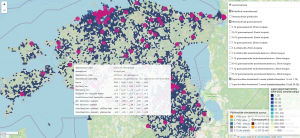According to the Foresight Centre’s short report “Green investment trends of companies in Estonia and Europe”, Estonian companies’ involvement in green investment is similar to the rest of Europe, although considerably fewer companies invest in energy production.
News
According to the new report by the Foresight Centre, attracting industries with high energy consumption to Estonia requires the added value of the projects per unit of energy to not be lower than the average. Establishing energy-intensive industries would only be justified if they could bring opportunities for economic activities that would create more added value in Estonia.
In today’s short report, the Foresight Centre presents a selection of various options for linking current social and educational benefits with people’s income, analysing the effect the changes would have on poverty, inequality and the state budget.
In Estonia, one in three grade 7-12 mathematics teachers is 60 or older. In the next decade, nearly 600 new mathematics teachers will be required to replace retiring teachers. Although two-thirds of those who have studied to become mathematics teachers stay in the profession, the number of new generation teachers is only about half of what is required. The need for new mathematics teachers is the greatest in Lääne County and Rapla County, according to the Foresight Centre’s short report ‘The need for the next generation of mathematics teachers and their alternative job opportunities’.
The average salary of Estonian teachers increased by more than 420 euros last year and reached 120% of the Estonian average, meeting the target set in the education development plan. However, due to the rapid growth of the average salary, this level of growth rate will be difficult to maintain, according to the Foresight Centre’s report ‘Teachers’ Salaries’.
Kaupo Koppel, an analyst with extensive experience, started working as an expert at the Foresight Centre.
Since the beginning of the full-scale war in Ukraine, the import of goods and services from Russia and Belarus has decreased nearly tenfold, while exports have increased, according to the recent short report by the Foresight Centre.
According to Foresight Centre’s short report ‘Community Schools in Estonia’, transforming local schools and kindergartens into modern community houses would help to revitalise public services in danger of closure. For example, remote work offices, family doctor and youth centres, as well as various sports and hobby groups could be located there. However, although this model offers the greatest benefits to peripheral regions, the municipalities of Harju County are currently more active in creating such multifunctional houses.
Short-term energy storage would help solar panel owners to increase the profitability of their electricity production, which would also help keep the Estonian power system in balance, according to an analysis commissioned by the Foresight Centre.
The Foresight Centre created a map application of the Estonian school network, where you can see where Estonian schools are located and where children live. The application also shows the main indicators of general education schools for the last five years and a simulation of the schools’ futures based on today’s birth rates.

 An independent think tank at the Riigikogu
An independent think tank at the Riigikogu 







